Bochnia Salt Mine
 Underground church created in early 18th century |
|
| UNESCO World Heritage Site | |
|---|---|
| Location |
Poland |
| Criteria | iv |
| Reference | 32 |
| Coordinates | 49°58′09″N 20°25′03″E / 49.9692°N 20.4175°E |
| Inscription | 1978 (2nd Session) |
| Extensions | 2008, 2013 |
| Endangered | 1989–1998 |
| Website | www |
|
[]
|
|
The Bochnia Salt Mine (Polish: kopalnia soli w Bochni) in Bochnia, Poland is one of the oldest salt mines in the world and the oldest one in Poland. The mine was established between the 12th and 13th centuries after salt was first discovered in Bochnia and became part of the Royal mining company żupy krakowskie (Kraków salt works).
The mine was closed some time after World War I. In 1981 it was declared a heritage monument. The site is one of Poland's official national Historic Monuments (Pomnik historii), as designated October 6, 2000 and tracked by the National Heritage Board of Poland.
The mine shafts measure 4.5 kilometres (2.8 mi) in length at about 330–468 metres in depth below the surface, at 16 levels.
In 2013 the mine was added to the UNESCO World Heritage List as an extension of the Wieliczka Salt Mine inscription of 1978.
The August Passage is the main communication and transportation route in the mine. It runs from the east to the west of mine, connecting in a straight line the bottom ends of the Campi and Sutoris shafts. It is at a depth of 176m from the top of the Sutoris shaft and 212m counting from the top of the Campi shaft. The August Passage was initially called the Long Stove (Piec Długi). Its first part, extending between the Rabsztyn Chute and a Campi Shaft, was built in the years 1723-1743, in accordance with a design by Jan Gottfried Borlach. His great achievements was to regulate routes in the mine by ensuring their straightening and leveling. As a result of this, over the next decades, the August Passage was able to reach a length of nearly 3 km (2 mi).
Excavated chambers, shafts and passages form an underground town, which is open to sightseers. The largest of the preserved chambers has been converted into a sanatorium.
The Ważyn Chamber was named after the name of the administrator (podżupek) Andrzej Ważyński. The deepness of this chamber, the biggest in Bochnia Salt Mine, is 248m; its length is 255m; its maximum width is 14.4m; and maximum height is 7.2m. The chamber uses no supporting pillars. Salt from Ważyn chamber was extracted from 1697 until the 1950s. For the purposes of creating a sanatorium these old pits were expanded with a loading-hauling-dumping (LHD) unit machine. These works took place until 1984. Thanks to them the Ernest Chute from the 17th century impressively presents itself on the stripped chamber's roof.
...
Wikipedia

